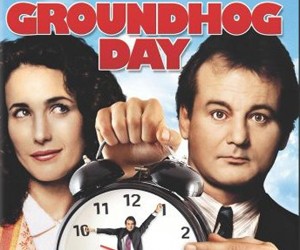 One of my favorite, and one of the most under-appreciated holidays is Groundhog Day. While millions of Americans turn to Punxsutawney, Pennsylvania to see the groundhog’s predictions for the end of this winter season, many others fondly remember Groundhog Day through the prism of the beloved 1993 comedy.
One of my favorite, and one of the most under-appreciated holidays is Groundhog Day. While millions of Americans turn to Punxsutawney, Pennsylvania to see the groundhog’s predictions for the end of this winter season, many others fondly remember Groundhog Day through the prism of the beloved 1993 comedy.
In the film, news anchor Phil Connors (Played by Bill Murray) travels to Punxsutawney to cover the Groundhog Day ceremony, only to relive the day over and over again with no end in sight. Connors tries various methods (often extreme) to get the repetition to end, but only ends up reaching February 3 when he saves lives, fulfills career goals and develops a romance. Could this modern-day parable on the pitfalls of repetition provide important advice for PR pros?
The Mail Merge Pitch
Everyone in our industry knows well the convenience of mail merge, as a useful function on word processors that allows for widespread mail (and, more importantly, email) message sending. When you’re pitching a lot of reporters and hoping one will hook, mail merge provides the essential toolset for maximum audience reach with minimal input. But with this ease comes major drawbacks. The ability to mass-send messages in relatively short order increases the temptation to keep spamming reporters to no end until they ask to be taken off your lists. Having spoken personally to a few reporters about this, I know that mail merge can depersonalize pitching and remove incentive for a reporter to get to know you. Reporters do not want to feel that you are emailing them the same material, over and over again. Or that you are emailing the same material to them and everyone else.
Some of these problems were highlighted in a recent post, that noted the way RH Strategic avoids this repetition: By individualizing outreach efforts, doing our due diligence on the reporter and issue at hand, and establishing a personal relationship upon which to build future stories.
Stale Messaging
One of the most important components of a strong public relations effort is strong, consistent messaging. Strong messaging allows you to play your game in your court AND avoid getting lost in the news cycle, or in some cases, losing a war of the words to opposition. In fact, some of the worst blunders in communications history come from spokespeople who stray too far from their message.
It’s important to avoid repeating the same handful of messages to any question that’s asked. Spokespeople sometimes become too comfortable recycling the same top points rather than engaging in real discussion. To alleviate this problem, our responsibility is to keep messaging fresh and relevant with the contemporary issues. RH Strategic has a tested way of doing just that.
Repetitive Workflow
This is thematically different from the previous two repetitive errors, because it deals more with workflow and client management rather than PR best practices. Nevertheless, this kind of repetition can derail an entire account.
Say you are working on a bylined article for a publication with an evergreen topic that has no firm deadline. Or maybe you are working on a white paper for a government relations or research-intensive client that needs it to be done “soon.” Without firm external deadlines, these projects can sometime fall by the wayside and get lost in day-to-day account work. When you check in with a client, be it daily, weekly or monthly, they will hear you give the same updates. “We’re still working on it“or “We’ll have an update soon.” The client will inevitably feel a “Groundhog Day” effect when these same updates (or lack thereof) come up every week during meetings.
It’s important for all PR professionals to prioritize their account projects, ranging from the urgent (news cycle pitching, social media, upcoming testimony) to the long-term (strategic planning, byline writing, research projects). If a long-term project is strongly prioritized, then work on it on as regular a basis as your schedule allows. If it falls off the radar because it’s no longer important, then sometimes you have to let the project go.
Do you have a story about overcoming the repetition that can accompany your account work? Leave a comment below, or tweet us at @RHStrategic with the hashtag #RHetoricBlog. We’d love to hear from fellow PR professionals and journalists alike!

